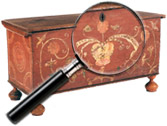|
|
Lard Fueled Lamps
The introduction of lard lamps, circa 1835, came in response to the widespread use of whale oil and other fluid oil lamps. These liquid fuels were dangerous to handle and the less expensive grades were smokey and poor illuminators. Lard, on the other hand, was safer as a solid, easily stored and could be inexpensively made at home.
The primary difficulty with lard was getting the thick fat to flow up [...] Click here to continue reading.
Feather Edge Earthenwares
Feather Edge is a period term used by English potters and American importers for common 18th century creamware items having an embossed “comma-like” rim design. The term is specifically used in pattern books published by Wedgwood, Leeds, Castleford and the Don Pottery. It is most often found on plates and platters, but occasionally appears on hollowwares.
The term “feather edge” is frequently misused to describe pearlwares with molded and colored rims. [...] Click here to continue reading.
Shell Edge Earthenwares
Shell edge is a period term used by English potters and American importers for an impressed molded rim pattern on pearlware most commonly painted blue or green edging, but occasionally puce or red. The motif is found on flatware, hollowware and ornamental figures and was exported in great quantities to the American market in the very early 19th century.
Shell edge ware is frequently incorrectly called “feather-edge” or Leeds ware. When [...] Click here to continue reading.
America and Independence Series Historical Staffordshire
The “America and Independence” series is so named for the two female allagorical figures flanking a central view of various buildings in naturalistic settings. “America” on the left holds aloft a portrait of Washington; on the right “Liberty” kneels with a pike topped with a Liberty cap. At least fifteen central views, mostly fictional, have been identified in the series. A ribbon festoon border with fifteen states named [...] Click here to continue reading.
Definition: ‘Pickwick’
A “pickwick” is a small tool used, circa 1830 to 1870, to manipulate or adjust the wick in whale oil and burning fluid lamps. The tool was commonly a metal pin held in a decorative handle of turned or carved wood, ivory or bone, and occasionally glass.
Richard Grenville, 1st Earl of Temple
Grenville was an English politician who opposed the conciliation of the American colonies. He was a member of Parliament from 1734-52, served as first lord of the admiralty (1756-1757), and lord privy seal (1757-1761) under the elder Pitt, with whom he later quarreled over the Stamp Act.
William Gould, 18th Century London Silversmith
William Gould was apprenticed to his silversmith father James in 1723 and obtained his freedom in 1733, made a Liveryman in 1746 and resigned in 1763.
Twenty cent pieces were made between 1875 and 1878.
Revenue Cutters were used in the 1920′s to intercept smugglers attempting to bring alcohol into prohibition-time America.
The C. F. Monroe Co.
The C.F. Monroe Co. operated a glass manufacturing and decorating factory from 1880 to 1916 in Meridian, Connecticut. Its three primary products were “Wave Crest”, “Nakara” and “Kelva” decorated art glass wares. These wares are very similar in form and decoration and are distinguished most easily by their associated marks. Monroe imported glass blanks from France and purchased others from the Pairpoint glass company for decoration with satin and [...] Click here to continue reading.
|
Recent Articles
- Charles Alfred Meurer – American Artist & Tromp L’Oeil Artist
- Sendak, Maurice – American Artist & Writer
- Godie, Lee – American Artist
- Davis, Vestie – American Artist
- Bartlett, Morton – American Artist
- Mackintosh, Dwight – American Artist
- Evans, Minnie Jones – African-American Artist
- Mumma, Ed (Mr. Eddy) – American Artist
- Nice, Don – American Artist
- Savitsky, John (Jack) – American Artist
- Gordon, Harold Theodore (Ted) – American Artist
- Dial, Thornton – African-American Artist
- Doyle Sam – American Artist
- Johnson, Lester Frederick – American Artist
- Finster, Howard – American Artist
|
|
